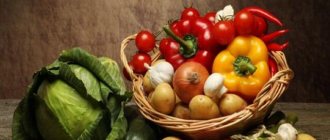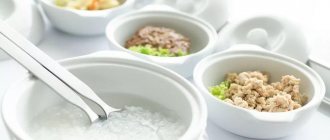General rules
Diet No. 6 (Table No. 6 according to Pevzner) was developed by the author with the aim of normalizing the metabolism of organic nitrogen-containing compounds ( purines ), reducing the level of uric acid and its salts in the body resulting from the metabolism of purines and changing the urine reaction to the alkaline side.
The diet is based on the fact that in case of metabolic disorders, in particular, a shift in urine pH below 5.75 (to the acidic side), the formation of sodium urate , which removes uric acid from the body, is reduced. Conditions are created for the formation of crystals of uric acid ( urate ), which are deposited in the joints and kidneys (kidney stones), causing diseases such as gout and urolithiasis , uric acid diathesis , cystinuria , oxaluria . When urine is alkalized, the solubility of urates increases, uric acid is removed from the body and the process of stone formation is disrupted.
Diet number 6 for gout
The therapeutic diet provides for a strict restriction in the diet of foods containing a large amount of purines , oxalic acid and a moderate restriction of sodium chloride (up to 10 g/day). At the same time, foods with an alkalizing effect (milk, vegetables/fruits) are introduced into the diet. There is a slighter limitation of proteins (up to 70-80 g) and fats (up to 80-90 g, mainly refractory). The amount of carbohydrates, in the absence of obesity, is at the level of 400 g. Drinking regimen - free liquid 2 liters or more. The energy value varies between 2700-3000 kcal. Meals for gout are 4-5 times a day, on an empty stomach and in between - drink plenty of fluids.
There are no special requirements for the culinary processing of products, with the exception of the processing of meat, which is prepared only by the cooking method with the need for preliminary short-term (10-15 minutes) boiling of the meat and draining the first broth before further processing, which allows reducing the purine content in the product. Meat dishes and fish can be included in the menu no more than 2-3 times a week (outside the period of exacerbation), and the amount of meat and fish should not exceed 150-170 g/day.
Diet No. 6 for gout, the weekly menu provides for fasting days once a week (fruit days - up to 1.5 kg of vegetables/fruits, cottage cheese-kefir - 1 liter of kefir and 400 g of low-fat cottage cheese), with an increase in the consumption of free food during this period liquid up to 2.5-3 liters (in the absence of contraindications). During an exacerbation, fasting days are carried out every other day. During this period, meat and fish are completely excluded from the diet.
The best option for exacerbation is a vegetarian diet , including fermented milk products, vegetable and milk soups, fruit infusions and herbal teas. This diet quickly alkalinizes the urine and significantly increases the solubility of uric acid .
Diet number six for gout
This diet is one of fifteen therapeutic nutrition systems developed by the Soviet scientist Mikhail Pevzner, and is often prescribed for gout.
While following diet number 6 for gout, you are allowed to consume:
- Rye, white and wheat bread.
- Borscht, beetroot soup, rassolnik, cabbage soup, fruit and vegetarian soups.
- Low-fat varieties of fish and meat (no more than twice a week).
- Various fruits, berries, vegetables in any form of preparation or natural form.
- Pasta or cereal dishes (in small quantities).
- One egg per day.
- Dishes made from milk, cottage cheese or lactic acid products.
- Dill and parsley, citric acid, sour cream, milk and tomato sauces.
- Weak tea, rosehip decoction, mineral waters (alkaline).
- Butter and vegetable oil.
The following are strictly excluded:
- Smoked meats, canned meat and fish, herring, sausages, kidneys, brains. In addition, liver, lungs, game, veal, mushroom, meat and fish broths, spicy cheese.
- Black pepper, mustard, horseradish, lingonberries, raspberries, figs, legumes, lettuce, sorrel.
- Strong tea, cocoa, natural coffee, chocolate.
- All alcoholic drinks, since uric acid excretion by the kidneys is impaired by alcohol.
Varieties
Variations of Diet No. 6 include Diet 6E . obese patients with similar indications or sometimes to patients with gout during an exacerbation to increase the effectiveness of treatment. Dietary Table 6E has a reduced energy value (1950-2000 Kcal), while the protein content is reduced to 70 g, fat - to 80 g, carbohydrates - to 250 g.
The diet mainly reduces the consumption of carbohydrates, mainly due to simple carbohydrates (sugar, honey, fresh wheat bread, flour and confectionery products, sweets) and to a lesser extent complex carbohydrates (cereals). Meat consumption is limited to 1-2 times a week. Fractional meals are provided up to 5-6 times a day, in small portions, drinking plenty of fluids, alkaline mineral water is especially recommended.
Vegetables and fruits are recommended to be consumed raw, or they can be baked or boiled. The diet is not physiologically complete and can be prescribed for a short period of time.
Nutritional Features
To obtain the maximum therapeutic effect while using Diet 6, it is important to pay attention to the following several features of proper nutrition:
- The diet includes eating 4-5 times a day.
- Single portions should be small, thereby reducing the functional load on the digestive system, improving the absorption of the main ingredients into the blood, and reducing the risk of developing fermentation and putrefactive processes in the intestinal lumen.
- It is recommended to take the last meal no later than 2 hours before expected sleep (in accordance with the latest gastroenterological recommendations, the period of time between dinner and bedtime increases to 3-4 hours).
- The diet is not gentle, so chopping food and dishes prepared from them is not recommended. For better absorption, it should be chewed thoroughly before swallowing.
- The temperature of the food consumed can vary within fairly wide limits. Avoid eating very hot or very cold foods.
- Steaming of food is allowed, it can be boiled, fried, stewed and baked.
Authorized Products
It is recommended to include most vegetables in the diet: carrots, white cabbage, zucchini, potatoes, cucumbers, eggplants, tomatoes. Fruits that are extremely healthy include pears, apples, oranges, plums, apricots and various berries. Meats can include turkey, chicken, rabbit. You can eat boiled fish and chicken eggs.
Milk, fermented milk products, low-fat varieties of cheese, low-fat cottage cheese and dishes made from it are especially useful in the diet. It is recommended to include various porridges prepared with diluted milk and pasta into the diet. Among fats, preference is given to vegetable oils, especially olive and flaxseed. It is allowed to introduce white and black bread into the diet.
Sweets allowed: jam, marshmallows, marmalade, marshmallows, non-chocolate candies. Drink - green tea, decoctions of rosehip, wheat bran, chicory, juices of vegetables, fruits, berries, fruit drinks, kvass. Be sure to include lingonberry fruit drinks, cucumber juice (up to 1 glass per day), and weakly mineralized alkaline mineral waters in your diet.
Table of permitted products
| Proteins, g | Fats, g | Carbohydrates, g | Calories, kcal | |
Vegetables and greens | ||||
| eggplant | 1,2 | 0,1 | 4,5 | 24 |
| zucchini | 0,6 | 0,3 | 4,6 | 24 |
| potato | 2,0 | 0,4 | 18,1 | 80 |
| carrot | 1,3 | 0,1 | 6,9 | 32 |
| cucumbers | 0,8 | 0,1 | 2,8 | 15 |
| tomatoes | 0,6 | 0,2 | 4,2 | 20 |
Fruits | ||||
| apricots | 0,9 | 0,1 | 10,8 | 41 |
| oranges | 0,9 | 0,2 | 8,1 | 36 |
| pears | 0,4 | 0,3 | 10,9 | 42 |
| plums | 0,8 | 0,3 | 9,6 | 42 |
| apples | 0,4 | 0,4 | 9,8 | 47 |
Nuts and dried fruits | ||||
| prunes | 2,3 | 0,7 | 57,5 | 231 |
Bakery products | ||||
| wheat bread | 8,1 | 1,0 | 48,8 | 242 |
| bran bread | 7,5 | 1,3 | 45,2 | 227 |
Confectionery | ||||
| jam | 0,3 | 0,2 | 63,0 | 263 |
| marshmallows | 0,8 | 0,0 | 78,5 | 304 |
| paste | 0,5 | 0,0 | 80,8 | 310 |
Raw materials and seasonings | ||||
| honey | 0,8 | 0,0 | 81,5 | 329 |
Dairy | ||||
| milk | 3,2 | 3,6 | 4,8 | 64 |
| kefir 2.5% | 2,8 | 2,5 | 3,9 | 50 |
| Ryazhenka 2.5% | 2,9 | 2,5 | 4,2 | 54 |
| curdled milk | 2,9 | 2,5 | 4,1 | 53 |
| acidophilus | 2,8 | 3,2 | 3,8 | 57 |
| yogurt | 4,3 | 2,0 | 6,2 | 60 |
Cheeses and cottage cheese | ||||
| sulguni cheese | 20,0 | 24,0 | 0,0 | 290 |
| cottage cheese 0.6% (low fat) | 18,0 | 0,6 | 1,8 | 88 |
Meat products | ||||
| rabbit | 21,0 | 8,0 | 0,0 | 156 |
Bird | ||||
| chicken | 16,0 | 14,0 | 0,0 | 190 |
| turkey | 19,2 | 0,7 | 0,0 | 84 |
Eggs | ||||
| chicken eggs | 12,7 | 10,9 | 0,7 | 157 |
Oils and fats | ||||
| butter | 0,5 | 82,5 | 0,8 | 748 |
| linseed oil | 0,0 | 99,8 | 0,0 | 898 |
| olive oil | 0,0 | 99,8 | 0,0 | 898 |
Non-alcoholic drinks | ||||
| green tea | 0,0 | 0,0 | 0,0 | — |
Juices and compotes | ||||
| cucumber juice | 0,8 | 0,1 | 2,5 | 14 |
| tomato juice | 1,1 | 0,2 | 3,8 | 21 |
| Apple juice | 0,4 | 0,4 | 9,8 | 42 |
| * data is per 100 g of product | ||||
What you can and cannot eat in the table
Our table will help you make the choice of foods for the “table 6” diet easier:
| Name of product and dish | What is allowed | What is prohibited |
| Broths | Vegetables | Meat, mushroom and fish, especially rich ones |
| Bread | Rye, with bran, yeast and cooked without dough, but not in large quantities | White, baking |
| Sugar | – | It should be limited as much as possible, including foods with sugar. |
| Vegetables | Zucchini, eggplant, carrots, cucumbers, peppers, beets, boiled, baked, stewed, raw. Salads and juices | Tomatoes, all types of cabbage can be very rare and little by little |
| Fruits | Apricots, green sour or sweet apples, pears, bananas, plums, juices from them. Fruits can be baked or eaten raw | Kiwi, lime, all citrus fruits. Jam, marmalade and marmalade |
| Dairy | Low-fat milk, sour cream, kefir, fermented baked milk, cottage cheese, butter, hard, soft and processed cheeses | Homemade butter, curd masses and cheeses, desserts |
| Canned food | – | Stew, sardines, caviar |
| Legumes | Lentils, soy, regular beans | Green peas and green beans |
| Salt | Minimum marine or Himalayan | Cooked (no more than 10 g) |
| Spices and everything spicy | – | Any (especially Korean vegetables, mushrooms and meat) |
| Fish | Medium fat, marine species - cod and hake, freshwater species - pike, carp and carp | Red (salmon, coho salmon, chum salmon, pink salmon) |
| Meat | Boiled low-fat variety, preferably white chicken, veal, turkey. You shouldn’t “indulge” more than 3 times a week | Duck, goose, especially pork |
| Smoked meats | – | Lard, brisket, boiled pork, ham, balyk |
| By-products | – | Liver, lung, udder, tongue, pates and rolls made from them |
| Pickles | – | Cabbage, cucumbers, tomatoes |
| Eggs | No more than 1 piece. in a day | – |
| Fat | – | Lamb, pork, beef |
| Sweets | Honey, marmalade, halva, marshmallow | – |
| Beverages | You can afford a decoction of rowan, mint or linden tea, fruit juice, kvass. If you want something hot, you should pay attention to cocoa | Coffee, strong tea, any alcohol |
| Cereals | All whole grains and cereals (especially green buckwheat, wheat bran, organic oatmeal) | Semolina, polished rice and millet, corn porridge |
| Vegetable oils | Corn, olive, sesame, flaxseed | Sunflower, as it is rich in fats |
| Pasta | Preferably from durum wheat (noodles, spaghetti, pasta, vermicelli) | – |
| Nuts | Walnuts, almonds, peanuts, pistachios, Brazilian, but in limited quantities | – |
For the “6” diet according to Pevzner to help, it is recommended to use products only from the proposed table.
Fully or partially limited products
The following are completely excluded from the diet: red meat (beef, pork, lamb) and offal (liver, heart, kidneys), fish (salted, fatty and fried), caviar, canned fish, seafood (shrimp, shellfish), any smoked meats. Limit pork, beef, lamb, and cooking fats. It is necessary to completely avoid foods rich in plant proteins. First of all, these are legumes (beans, lentils, peas, soybeans, beans), various spices (horseradish, pepper, mustard).
Cream cakes, chocolate, salty and spicy cheese pastries, as well as some berries - grapes, raspberries, cranberries, figs - are prohibited. The consumption of foods containing a lot of carbohydrates is limited: bread, pasta, various cereals with meat broth. It is undesirable to introduce mushrooms, spinach, cauliflower, sorrel, peppers, radishes, rhubarb, celery, and asparagus into the diet. Drinks include cocoa, tea and coffee. Limit salt consumption. Drinking alcohol, especially red wines, cognac and beer, is completely unacceptable.
Table of prohibited products
| Proteins, g | Fats, g | Carbohydrates, g | Calories, kcal | |
Vegetables and greens | ||||
| beans | 6,0 | 0,1 | 8,5 | 57 |
| peas | 6,0 | 0,0 | 9,0 | 60 |
| chickpeas | 19,0 | 6,0 | 61,0 | 364 |
| soybeans | 34,9 | 17,3 | 17,3 | 381 |
| beans | 7,8 | 0,5 | 21,5 | 123 |
| horseradish | 3,2 | 0,4 | 10,5 | 56 |
| lentils | 24,0 | 1,5 | 42,7 | 284 |
| sorrel | 1,5 | 0,3 | 2,9 | 19 |
Fruits | ||||
| figs | 0,7 | 0,2 | 13,7 | 49 |
Berries | ||||
| cranberry | 0,5 | 0,0 | 6,8 | 26 |
| raspberries | 0,8 | 0,5 | 8,3 | 46 |
Mushrooms | ||||
| mushrooms | 3,5 | 2,0 | 2,5 | 30 |
Flour and pasta | ||||
| pasta | 10,4 | 1,1 | 69,7 | 337 |
Chocolate | ||||
| chocolate | 5,4 | 35,3 | 56,5 | 544 |
Raw materials and seasonings | ||||
| mustard | 5,7 | 6,4 | 22,0 | 162 |
| mayonnaise | 2,4 | 67,0 | 3,9 | 627 |
Meat products | ||||
| pork | 16,0 | 21,6 | 0,0 | 259 |
| pork liver | 18,8 | 3,6 | 0,0 | 108 |
| pork kidneys | 13,0 | 3,1 | 0,0 | 80 |
| salo | 2,4 | 89,0 | 0,0 | 797 |
| beef | 18,9 | 19,4 | 0,0 | 187 |
| beef liver | 17,4 | 3,1 | 0,0 | 98 |
| beef brains | 9,5 | 9,5 | 0,0 | 124 |
| mutton | 15,6 | 16,3 | 0,0 | 209 |
| bacon | 23,0 | 45,0 | 0,0 | 500 |
Sausages | ||||
| smoked sausage | 28,2 | 27,5 | 0,0 | 360 |
Fish and seafood | ||||
| pink salmon | 20,5 | 6,5 | 0,0 | 142 |
| Red caviar | 32,0 | 15,0 | 0,0 | 263 |
| squid | 21,2 | 2,8 | 2,0 | 122 |
| shrimps | 22,0 | 1,0 | 0,0 | 97 |
| salmon | 19,8 | 6,3 | 0,0 | 142 |
| mussels | 9,1 | 1,5 | 0,0 | 50 |
| herring | 16,3 | 10,7 | — | 161 |
| salmon | 21,6 | 6,0 | — | 140 |
| mackerel | 18,0 | 13,2 | 0,0 | 191 |
Oils and fats | ||||
| animal fat | 0,0 | 99,7 | 0,0 | 897 |
| cooking fat | 0,0 | 99,7 | 0,0 | 897 |
Alcoholic drinks | ||||
| red dessert wine | 0,5 | 0,0 | 20,0 | 172 |
| vodka | 0,0 | 0,0 | 0,1 | 235 |
| cognac | 0,0 | 0,0 | 0,1 | 239 |
| liquor | 0,3 | 1,1 | 17,2 | 242 |
| beer | 0,3 | 0,0 | 4,6 | 42 |
Non-alcoholic drinks | ||||
| coffee | 0,2 | 0,0 | 0,3 | 2 |
| black tea | 20,0 | 5,1 | 6,9 | 152 |
| * data is per 100 g of product | ||||
What products are prohibited?
The diet means that some foods should be completely excluded from the diet. Let's look at the prohibited list:
- First of all, you need to give up fatty fish and meat.
- We exclude ayran and other carbonated drinks from fermented milk drinks.
- All salty foods are prohibited. For example, dried/cured fish, salted cheese, chips, crackers, sauces and other fast food.
- Cocoa, strong tea, coffee.
- Pickled and canned foods.
- Cookies, cakes, chocolate and chocolate candies, ice cream.
- Greens containing oxalic acid: sorrel, spinach, rhubarb.
- All flour products, baked goods, margarine and products containing it.
- Alcohol-containing drinks.
- The group of legumes should be excluded from vegetables: peas, beans, beans, etc.).
- The first broths.
It is important! If the disease worsens, this list can be adjusted.
Menu
The menu for the week is compiled based on the list of permitted and prohibited foods, taking into account the acceptable methods of culinary processing of foods and the patient’s diet.
Monday
| Breakfast |
|
| Lunch |
|
| Dinner |
|
| Dinner |
|
| For the night |
|
Tuesday
| Breakfast |
|
| Lunch |
|
| Dinner |
|
| Dinner |
|
| For the night |
|
Wednesday
| Breakfast |
|
| Lunch |
|
| Dinner |
|
| Dinner |
|
| For the night |
|
Thursday
| Breakfast |
|
| Lunch |
|
| Dinner |
|
| Dinner |
|
| For the night |
|
Friday
| Breakfast |
|
| Lunch |
|
| Dinner |
|
| Dinner |
|
| For the night |
|
Saturday
| Breakfast |
|
| Lunch |
|
| Dinner |
|
| Dinner |
|
| For the night |
|
Sunday
| Breakfast |
|
| Lunch |
|
| Dinner |
|
| Dinner |
|
| For the night |
|
Diet table 6: what is possible, what is not?
During diet No. 6, the following foods and dishes are recommended:
- Rye and wheat bread from first and second grade flour.
- Salads from pickled and fresh vegetables.
- Potato soups with cereals, cabbage soup, vegetarian borscht.
- Poultry, fish, meat – lean, baked or boiled (no more than three times a week).
- Cottage cheese, fermented milk products, milk and dishes made from it.
- Any cereals in small quantities.
- One egg per day (prepared in any way).
- Any vegetables, with the exception of legumes.
- Berries and fruits in large quantities.
- Fruit and milk jelly and creams.
- Sauces based on vegetable broth, milk or tomato.
- Honey, pastille, marmalade, jam.
- Lemons, oranges, grapefruits (in moderation). Alkaline mineral waters.
It is necessary to exclude from the diet:
- Mushroom, strong fish and meat broths.
- Canned food, smoked meats, sausage, sausages, bacon.
- Young meat.
- Lamb, beef and cooking fats.
- Bean and sorrel soups.
- Kidneys, liver, tongue, lungs (all offal).
- Salted and dried fish.
- Spicy snack cheeses.
- Pickled and salted vegetables.
- Strong tea, cocoa, coffee, chocolate, cranberries, raspberries.
- All dried fruits, except prunes.
- Confectionery with powdered sugar and salt, cookies.
- Sauces based on mushroom, meat and fish broth.
- Limit foods that have a stimulating effect on the nervous system - spicy snacks, strong tea, spices, cocoa and chocolate.
- Any drinks containing alcohol.
Sample diet menu No. 6 for one day:
breakfast - vegetable salad with vegetable oil, carrot pudding with apples and millet, soft-boiled egg, tea. Second breakfast - rosehip decoction. Lunch – milk noodle soup, jelly, fried potato cutlets. Afternoon snack – fresh apples. Dinner – cabbage rolls stuffed with vegetables and rice, tea, cheesecakes. At night you can drink a decoction of wheat bran.
Reviews and results
The overwhelming number of reviews indicate that this dietary Table No. 6 is quite effective for gout and allows you to relatively quickly, together with medicinal drugs, relieve an exacerbation and normalize metabolism in the body.
- “... I have been suffering from gout for 15 years, as soon as an exacerbation begins, I go on a diet, and I do a one-day fast, then 2-3 days of vegetarian food, and then Table 6 and increase physical activity - I go to the gym. This is how I save myself”;
- “... I am 45 years old and I have also had gout for almost 10 years. Twice a year, at least attacks, Uric acid goes off scale, almost twice the norm. Probably because the kidneys are sick. The pain is severe, such that I move around the house on crutches. I relieve pain with Ketanov tablets and immediately go on a diet. I practice fasting days, drink a lot of fluids. Usually after 2-3 weeks it gradually goes away, and I return to normal life.”
For what diseases is it indicated?
It is mandatory for patients with gout, which most often affects men. It is strongly recommended to adhere to it constantly, even during remission.
See also: Do's and don'ts of diet number 10.
The main goal is to reduce the amount of uric acid in the blood, joints and liver, and normalize purine metabolism. This is also true for those who have been diagnosed with urolithiasis, in which urate stones form in the kidneys, ureter and bladder. It is also recommended to adhere to such a diet for cystinuria and oxaluria.










